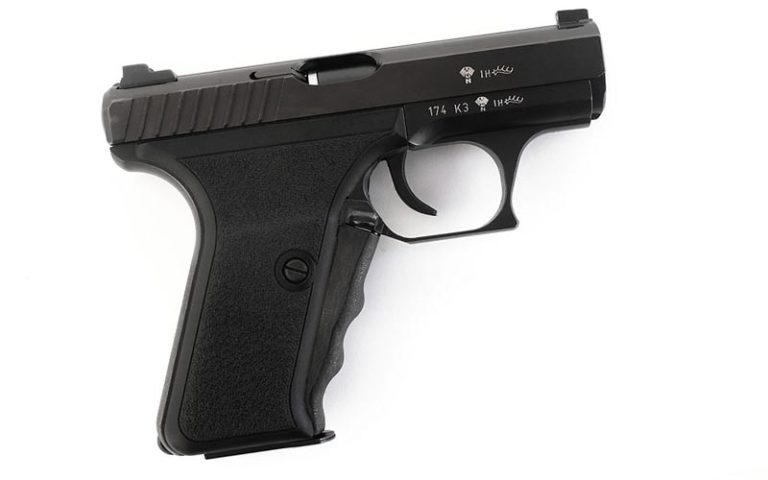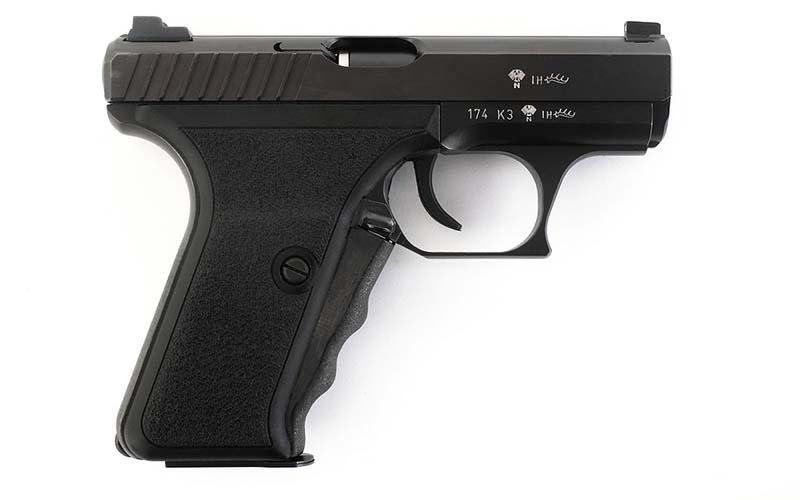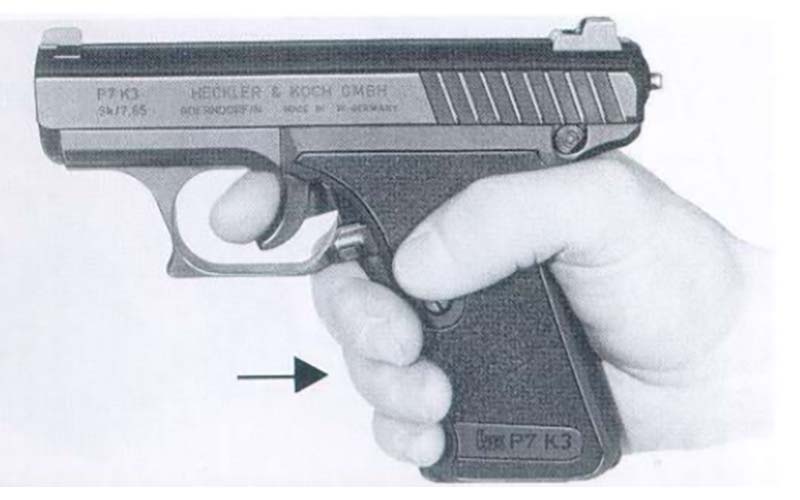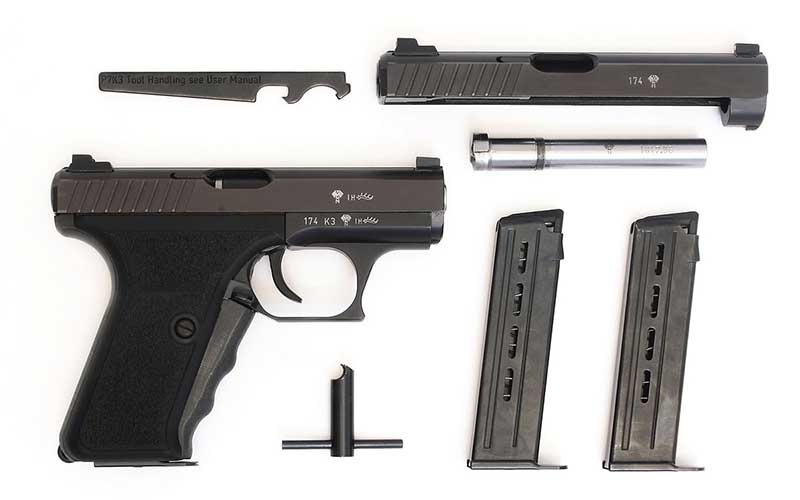
Even rarer than the standard versions, the HK P7K3 pocket pistol variant may be this gun’s best iteration.
HK P7K3 Dimensions:
- Overall Length: 6.3-Inches
- Height: 4.92-Inches
- Width: 1.14-Inches
- Weight (Unloaded): ~1.8-Pounds
Any variant of the H&K P7 commands a high price in the United States. In fact, it even commanded a high price in Germany when it was first released in the late 1970s. Its sparse importation into the U.S. combined with its original marketing slogan of “the most expensive handgun in the world” make the P7 more of a collectible for most people than a shooter. In practical terms, the P7 is inaccessible to most, but its unique and innovative design features have kept it in the public consciousness all these years later. The P7 has been lauded as a carry pistol by the few who are lucky enough to use one as such. But of all the variants which were imported, it seems that the exceedingly rare HK P7K3 may fill this role better than any other.

HK P7K3 Design Details
The smallest member of the P7 family, the HK P7K3 is quite a bit different than any of its bigger brothers. Because of the smaller calibers it's chambered for, the P7K3 does not need the gas-delaying mechanism found in the standard variants, instead of utilizing a direct blowback action with a hydraulic buffer. This difference in operation allows the P7K3 to use a non-fixed barrel as well, making changing calibers a possibility that didn’t exist with the other fixed-barrel models. The barrel, slide and magazines can be swapped out to shoot either .380 ACP, .32 ACP or .22LR. Because part of the reason the P7K3 was developed was for use as a training gun, the ability to use smaller and cheaper calibers is a logical addition. Regardless of caliber, every P7K3 magazine has an 8-round capacity.
The squeeze-cocker mechanism which lies at the heart of the P7 family is of course still present on the HK P7K3, and it may be even more at home in the smaller variant. Unlike on a traditional striker-fired gun which is primed by pulling the trigger, P7 strikers are primed by grabbing them by the squeeze-cocker. By removing the mechanical burden of priming the striker from the trigger, P7s are able to have very nice single-stage triggers with very little take-up.

The squeeze-cocker is also what enables the HK P7K3 to sit comfortably within the category of “pocket pistol” despite being larger than most others. This is because the nature of the squeeze-cocking mechanism requires it to be firmly grasped in a shooting position to render it usable. If the grip safety on something like a 1911 were to fail, the cocked hammer still stores enough potential energy to detonate the round if it were to fall. The striker on the P7 family is only cocked when the squeeze-cocker is depressed, meaning if it were to fail for some reason a chambered round would be unable to fire. It's this detail that makes the HK P7K3 ideal for pocket carry, as it is one of the few guns which can be confidently carried outside of a holster with a round in the chamber. Because of the amount of force needed to cock the P7’s striker, it would be virtually impossible for it to both be accidentally depressed within one’s pocket and for the trigger to be pulled. Intent is needed to make this gun fire, making it an extremely safe carry piece.
Smaller But Better
When the standard HK P7 was first launched in Germany some of the promotional material described it as “the best combat handgun in the world.” While certainly nice pistols, they have one glaring flaw that stops them from truly being a “combat handgun.” The squeeze cocker mechanism which gives the P7 its excellent trigger and superior safety is also what limits this gun’s utility in a prolonged firefight, as the gas-delayed blowback action will eventually make the grip too hot to handle. While it may seem counterintuitive, this is exactly what makes the HK P7K3 a potentially better combat pistol than any of its full-sized counterparts.
The smaller caliber of the HK P7K3 enables it to utilize its straight blowback action, resulting in less hot gas building up inside the gun than does within the gas-delayed blowbacks of other P7s. While I have not had the chance to directly test a P7K3 against a standard P7, it stands to reason that because of these different operating systems that the P7K3 would tolerate many more rounds downrange before it overheated.
Its increased resistance to overheating combined with its smaller size helps make the P7K3 the superior model both for carrying and for prolonged shooting.

The HK P7K3 may exist as a footnote in a family of already fairly obscure firearms, but for those in the market for a high-quality carry piece that can be safely shoved in a pocket, there might not be a better option available than this.
For more H&K pistols, please visit hk-usa.com.
More Pocket Guns:
- Pocket Pistols: Still Viable For Defense?
- The Fascinating History Of Bicycle Guns
- Classic Pocket Pistol: Colt 1903
- The L.W. Seecamp 32
- The Bond Arms PT2A Derringer

Next Step: Get your FREE Printable Target Pack
Enhance your shooting precision with our 62 MOA Targets, perfect for rifles and handguns. Crafted in collaboration with Storm Tactical for accuracy and versatility.
Subscribe to the Gun Digest email newsletter and get your downloadable target pack sent straight to your inbox. Stay updated with the latest firearms info in the industry.

![Best Concealed Carry Guns In 2025 [Field Tested] Wilson Combat EDC X9S 1](https://gundigest.com/wp-content/uploads/Wilson-Combat-EDC-X9S-1-324x160.jpg)


![Best 9mm Carbine: Affordable PCCs [Tested] Ruger Carbine Shooting](https://gundigest.com/wp-content/uploads/Ruger-Carbine-Shooting-100x70.jpg)
![Best AR-15: Top Options Available Today [Field Tested] Harrington and Richardson PSA XM177E2 feature](https://gundigest.com/wp-content/uploads/Harrington-and-Richardson-PSA-XM177E2-feature-100x70.jpg)

dacian is an idiot for all of the reasons he mentioned.
I recommend this gun it is most durable, reliable handguns
I have two 9 mm P7’s My first was the original European version with the magazine release at the base of the grip and the second, a P7M8 that I was able to purchase just prior to them being discontinued. I have shot both extensively. At training schools I have fired several hundred rounds over 4 day training classes and never had a problem with the grip getting hot or experienced a cook off in the magazine. When I draw the squeeze cocker is not depressed until the pistol is extended in a two handed push pull grip. This one of the great personal firearms.
The gun could not be used with low cost lead bullets
It was not a reliable gun with all brands of ammunition because slower burning powders did not work well in the gun and would cause a dangerous condition of opening the action too soon when the gun was fired
The cocking lever was so stiff that it could not be held in for very long making slow fire shooting about impossible with any degree of accuracy
It had a propensity to break firing pins (striker) and one Maryland cop was killed in a fire fight because of this.
It was a dangerous gun for cops to draw out of the holster because when one would grip the gun it was now cocked and ready to fire which resulted in many cops accidentally shooting themselves or others.
he HK P7 /P13 were total failures in the marketplace for many reasons.
It was way overpriced
It was a heavy gun
Its mushy trigger pull did not let the operator know precisely when the gun was going off.
Because of its poorly designed gas system the gun overheated to the point where cartridge’s could and often did cook off creating a hazard to the shooter and people in the vicinity.
Its loud cocking lever made a very loud clickety clack when uncocking the weapon giving away ones hidden position in a fight.
test